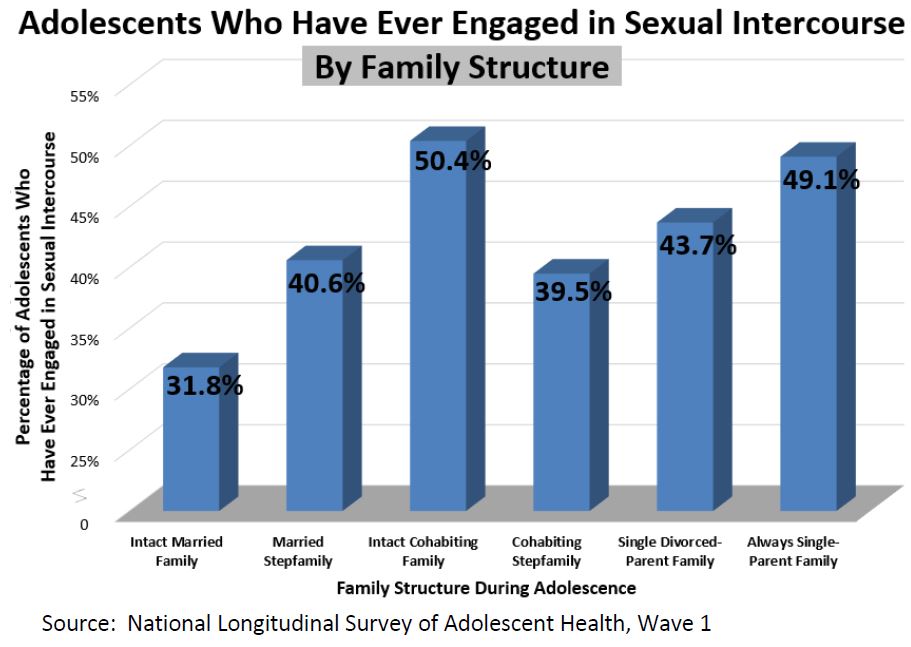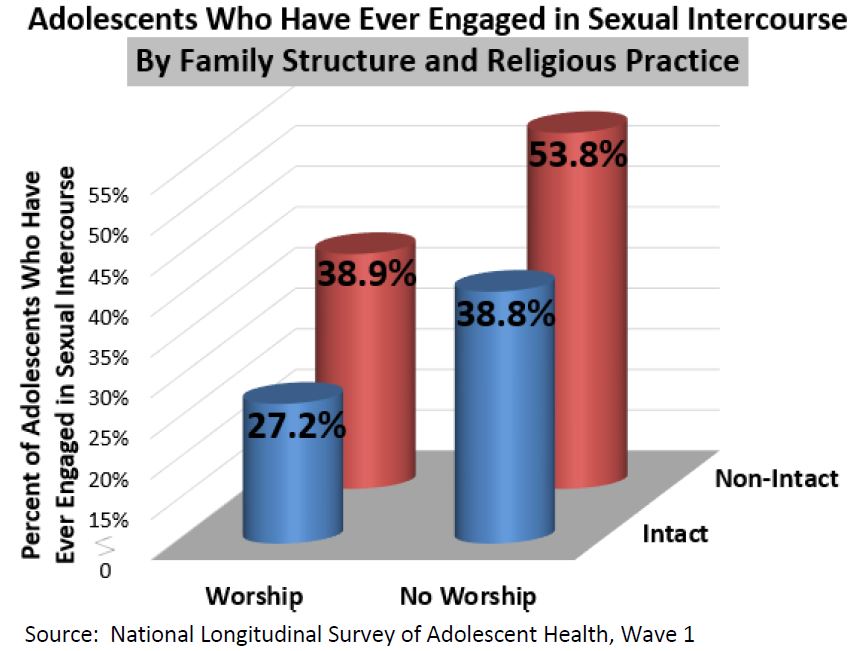Click Here to download “Adolescents Who Have Ever Engaged in Sexual Intercourse by Family Structure and Religious Practice”
Adolescents Who Have Ever Engaged in Sexual Intercourse by Family Structure and Religious Practice
Wave I of the National Longitudinal Survey of Adolescent Health (Add Health)
[1] found that teenagers in intact families that worshipped weekly were least likely to have engaged in sexual intercourse.
[2]
Family Structure: At the time of the survey, fewer 13- to 19-year-olds in intact families had ever engaged in sexual intercourse than those in non-intact families. Adolescents in intact married families were least likely to have ever had sex (31.8%), followed by those in cohabiting stepfamilies (39.5%), married stepfamilies (40.6%), single-parent divorced families (43.7%), and always single-parent families (49.1%). Teenagers from intact cohabiting families were most likely to have ever had sexual intercourse (50.4%).
 Religious Practice:
Religious Practice: The likelihood that an adolescent had ever had sex decreased as the adolescent’s religious involvement increased. Thirteen to nineteen year-olds who attended religious services weekly or more within the past year were less likely to have engaged in sexual intercourse (30.9%) than those who attended less than monthly but not weekly (36.0%), less than monthly (39.9%), or never (44.9%).
 Family Structure and Religious Practice Combined:
Family Structure and Religious Practice Combined: Teenagers in intact worshipping families were least likely to have ever engaged in sexual intercourse (27.2%). Thirteen to nineteen year olds in intact non-worshipping families (38.8%) and non-intact worshipping families (38.9%) were more likely to have ever had sex. Teenagers in non-intact families that did not worship were most likely to have engaged in sexual intercourse (53.8%).
 Related Insights from Other Studies:
Related Insights from Other Studies: A large body of research shows that teens who worship frequently are less likely to be sexually active. Likewise, youth who receive spiritual support from friends and family are less likely to engage in sex, and girls who attend church are less likely to experience a teenage pregnancy.
[3] Eva S. Lefkowitz, Meghan M. Gillen, Cindy L. Shearer, and Tanya L. Boone found that religious behavior was the strongest predictor of sexual behavior.
[4]
Studies have found that teenagers who place a large emphasis on religion are less likely to engage in risky behaviors. They are less likely to abuse alcohol, use marijuana, smoke,
[5] or engage in delinquency.
[6] Frequent religious worship among adolescents is a powerful good that will naturally benefit society.
[1] The National Longitudinal Survey of Adolescent Health (Add Health) is a congressionally-mandated longitudinal survey of American adolescents. Add Health interviewed a random sample of 20,745 adolescents aged 13-19 in 1995 drawn from junior high and high schools (Wave I) and has followed them in successive waves in 2001 (Wave III) and 2009 (Wave IV).
[2] These charts draw on data collected by the National Longitudinal Survey of Adolescent Health (Add Health), Wave I
[3] Sharon S. Rostosky, Brian L. Wilcox, Margaret L.C. Wright, and Brandy Randall, “The Impact of religiosity on Adolescent Sexual Behavior: A Review of the Evidence,”
Journal of Adolescent Research: 19 (2004): 677-697.
[4] Eva S. Lefkowitz, Meghan M. Gillen, Cindy L. Shearer, and Tanya L. Boone, “Religiosity, Sexual Behaviors, and Sexual Attitudes During Emerging Adulthood,”
The Journal of Sex Research 41 (2004): 150-159.
[5] Jill W. Sinha, Ram A. Cnaan, and Richard J. Gelles, “Adolescent Risk Behaviors and Religion: Findings from a National Study,”
Journal of Adolescence: 30 (2007): 231–249.
[6] Mark D. Regnerus and Glenn H. Elder, “Religion and Vulnerability Among Low-Risk Adolescents,”
Social Science Research: 32 (2003): 633–658.]]>
 Religious Practice: The likelihood that an adolescent had ever had sex decreased as the adolescent’s religious involvement increased. Thirteen to nineteen year-olds who attended religious services weekly or more within the past year were less likely to have engaged in sexual intercourse (30.9%) than those who attended less than monthly but not weekly (36.0%), less than monthly (39.9%), or never (44.9%).
Religious Practice: The likelihood that an adolescent had ever had sex decreased as the adolescent’s religious involvement increased. Thirteen to nineteen year-olds who attended religious services weekly or more within the past year were less likely to have engaged in sexual intercourse (30.9%) than those who attended less than monthly but not weekly (36.0%), less than monthly (39.9%), or never (44.9%).
 Family Structure and Religious Practice Combined: Teenagers in intact worshipping families were least likely to have ever engaged in sexual intercourse (27.2%). Thirteen to nineteen year olds in intact non-worshipping families (38.8%) and non-intact worshipping families (38.9%) were more likely to have ever had sex. Teenagers in non-intact families that did not worship were most likely to have engaged in sexual intercourse (53.8%).
Family Structure and Religious Practice Combined: Teenagers in intact worshipping families were least likely to have ever engaged in sexual intercourse (27.2%). Thirteen to nineteen year olds in intact non-worshipping families (38.8%) and non-intact worshipping families (38.9%) were more likely to have ever had sex. Teenagers in non-intact families that did not worship were most likely to have engaged in sexual intercourse (53.8%).
 Related Insights from Other Studies: A large body of research shows that teens who worship frequently are less likely to be sexually active. Likewise, youth who receive spiritual support from friends and family are less likely to engage in sex, and girls who attend church are less likely to experience a teenage pregnancy.[3] Eva S. Lefkowitz, Meghan M. Gillen, Cindy L. Shearer, and Tanya L. Boone found that religious behavior was the strongest predictor of sexual behavior.[4]
Studies have found that teenagers who place a large emphasis on religion are less likely to engage in risky behaviors. They are less likely to abuse alcohol, use marijuana, smoke,[5] or engage in delinquency.[6] Frequent religious worship among adolescents is a powerful good that will naturally benefit society.
[1] The National Longitudinal Survey of Adolescent Health (Add Health) is a congressionally-mandated longitudinal survey of American adolescents. Add Health interviewed a random sample of 20,745 adolescents aged 13-19 in 1995 drawn from junior high and high schools (Wave I) and has followed them in successive waves in 2001 (Wave III) and 2009 (Wave IV).
[2] These charts draw on data collected by the National Longitudinal Survey of Adolescent Health (Add Health), Wave I
[3] Sharon S. Rostosky, Brian L. Wilcox, Margaret L.C. Wright, and Brandy Randall, “The Impact of religiosity on Adolescent Sexual Behavior: A Review of the Evidence,” Journal of Adolescent Research: 19 (2004): 677-697.
[4] Eva S. Lefkowitz, Meghan M. Gillen, Cindy L. Shearer, and Tanya L. Boone, “Religiosity, Sexual Behaviors, and Sexual Attitudes During Emerging Adulthood,” The Journal of Sex Research 41 (2004): 150-159.
[5] Jill W. Sinha, Ram A. Cnaan, and Richard J. Gelles, “Adolescent Risk Behaviors and Religion: Findings from a National Study,” Journal of Adolescence: 30 (2007): 231–249.
[6] Mark D. Regnerus and Glenn H. Elder, “Religion and Vulnerability Among Low-Risk Adolescents,” Social Science Research: 32 (2003): 633–658.]]>
Related Insights from Other Studies: A large body of research shows that teens who worship frequently are less likely to be sexually active. Likewise, youth who receive spiritual support from friends and family are less likely to engage in sex, and girls who attend church are less likely to experience a teenage pregnancy.[3] Eva S. Lefkowitz, Meghan M. Gillen, Cindy L. Shearer, and Tanya L. Boone found that religious behavior was the strongest predictor of sexual behavior.[4]
Studies have found that teenagers who place a large emphasis on religion are less likely to engage in risky behaviors. They are less likely to abuse alcohol, use marijuana, smoke,[5] or engage in delinquency.[6] Frequent religious worship among adolescents is a powerful good that will naturally benefit society.
[1] The National Longitudinal Survey of Adolescent Health (Add Health) is a congressionally-mandated longitudinal survey of American adolescents. Add Health interviewed a random sample of 20,745 adolescents aged 13-19 in 1995 drawn from junior high and high schools (Wave I) and has followed them in successive waves in 2001 (Wave III) and 2009 (Wave IV).
[2] These charts draw on data collected by the National Longitudinal Survey of Adolescent Health (Add Health), Wave I
[3] Sharon S. Rostosky, Brian L. Wilcox, Margaret L.C. Wright, and Brandy Randall, “The Impact of religiosity on Adolescent Sexual Behavior: A Review of the Evidence,” Journal of Adolescent Research: 19 (2004): 677-697.
[4] Eva S. Lefkowitz, Meghan M. Gillen, Cindy L. Shearer, and Tanya L. Boone, “Religiosity, Sexual Behaviors, and Sexual Attitudes During Emerging Adulthood,” The Journal of Sex Research 41 (2004): 150-159.
[5] Jill W. Sinha, Ram A. Cnaan, and Richard J. Gelles, “Adolescent Risk Behaviors and Religion: Findings from a National Study,” Journal of Adolescence: 30 (2007): 231–249.
[6] Mark D. Regnerus and Glenn H. Elder, “Religion and Vulnerability Among Low-Risk Adolescents,” Social Science Research: 32 (2003): 633–658.]]>
